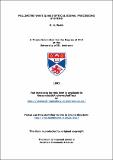Files in this item
Millimetre wave quasi-optical signal processing systems
Item metadata
| dc.contributor.advisor | Lesurf, J. C. G. | |
| dc.contributor.author | Webb, M. R. | |
| dc.coverage.spatial | 186 | en_US |
| dc.date.accessioned | 2012-06-20T13:51:34Z | |
| dc.date.available | 2012-06-20T13:51:34Z | |
| dc.date.issued | 1993 | |
| dc.identifier.uri | https://hdl.handle.net/10023/2827 | |
| dc.description.abstract | The development of spatial signal processing techniques at millimetre wavelengths represents an area of science and technology that is new. At optical wavelengths, spatial signal processing techniques are well developed and are being applied to a variety of situations. In particular they are being used in pattern recognition systems with a great deal of success. At millimetre wavelengths, the kind of technology used for signal transport and processing is typically either waveguide based or quasi-optically based, or some hybrid of the two. It is the use of quasi-optical methods that opens up the possibility of applying some of the spatial signal processing techiques that up to the present time have almost exclusively been used at optical wavelengths. A generic device that opens up this dimension of spatial signal processing to millimetre wave quasi-optical systems is at the heart of the work described within this thesis. The device could be suitably called a millimetre wave quasi-optical spatial light modulator (8LM), and is identical in operation to the spatial light modulators used in many optical signal processing systems. Within this thesis both a theoretical and an experimental analysis of a specific millimetre wave quasi-optical spatial light modulator is undertaken. This thesis thus represents an attempt to open up this new area of research and development, and to establish for it, a helpful theoretical and experimental foundation. It is an area that involves a heterogeneous mix of various technologies, and it is an area that is full of potential. The development of the experimental method for measuring the beam patterns produced by millimetre wave quasi-optical spatial light modulators involved the separate development of two other components. Firstly, a sensitive, low-cost millimetre wave pyroelectric detector has been developed and characterised. And secondly, a high performance quasi-optical Faraday rotator (a polarisation rotator) has been developed and characterised. The polarisation state of a quasi-optical beam is the parameter most often exploited for signal processing applications in millimetre wave quasi-optical systems, and thus a high performance polarisation rotator has readily found many opportunities for use. | en_US |
| dc.language.iso | en | en_US |
| dc.publisher | University of St Andrews | |
| dc.rights | Creative Commons Attribution-NonCommercial-NoDerivs 3.0 Unported | |
| dc.rights.uri | http://creativecommons.org/licenses/by-nc-nd/3.0/ | |
| dc.subject.lcc | TK7868.S5W3 | |
| dc.subject.lcsh | Pulse circuits | en_US |
| dc.subject.lcsh | Pulse techniques (Electronics) | en_US |
| dc.subject.lcsh | Pulse generators--Mathematical models | en_US |
| dc.title | Millimetre wave quasi-optical signal processing systems | en_US |
| dc.type | Thesis | en_US |
| dc.type.qualificationlevel | Doctoral | en_US |
| dc.type.qualificationname | PhD Doctor of Philosophy | en_US |
| dc.publisher.institution | The University of St Andrews | en_US |
This item appears in the following Collection(s)
Except where otherwise noted within the work, this item's licence for re-use is described as Creative Commons Attribution-NonCommercial-NoDerivs 3.0 Unported
Items in the St Andrews Research Repository are protected by copyright, with all rights reserved, unless otherwise indicated.


